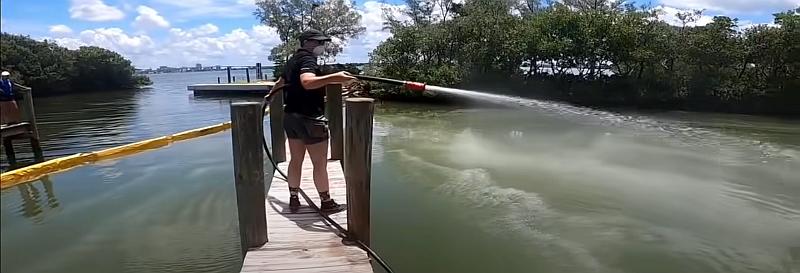 We recently posted about the latest round of red tide to hit the Gulf Coast of Florida. Florida red tide is caused by the blooming of the dinoflagellate Karenia brevis. K. brevis produces neurotoxins that can cause respiratory problems in humans and attack the central nervous systems of fish and other wildlife. In the latest outbreak, over 1,200 tons of dead fish and other marine life have washed up on Florida’s Gulf Coast.
We recently posted about the latest round of red tide to hit the Gulf Coast of Florida. Florida red tide is caused by the blooming of the dinoflagellate Karenia brevis. K. brevis produces neurotoxins that can cause respiratory problems in humans and attack the central nervous systems of fish and other wildlife. In the latest outbreak, over 1,200 tons of dead fish and other marine life have washed up on Florida’s Gulf Coast.
Now, scientists are testing a new and novel approach to battling the toxic algal bloom — spraying the red tide with a clay slurry.
As reported by ILFS, known as clay flocculation, the process involves spraying the water surface with a slurry of modified clay particles and seawater. The clay binds to the algae and sinks to the seabed. Eventually, the cells and toxins become buried. Many of the algal cells will also rupture when they make contact with the modified clay and die.
Researchers from Woods Hole Oceanographic Institute (WHOI), Mote Marine Laboratory & Aquarium, and the University of Central Florida recently rolled out this method to the canals and coast of Florida as part of an ongoing initiative that’s seen clay flocculation deployed at 25 other sites.
As for this recent project in Florida, the researchers will be keeping a close eye on the situation, frequently taking water samples from both the treatment area and non-treated area to see if they can perfect this method of controlling the red tide.
“This is just the first of what we hope will be several upcoming trials of clay flocculation on active blooms in the wild,” Dr. Don Anderson, Senior Scientist at WHOI and Principal Investigator for this Initiative project, said in a statement.
“What we learn here will help us better understand how conditions in Florida affect its success and how clay flocculation might be tailored to blooms of Karenia brevis, as well as other species of algae, here and elsewhere in the world,” added Dr. Anderson.
“In addition to cell abundance and toxin concentration, our team is evaluating phytoplankton community composition as well as multiple water quality measurements before, during and after the clay application to determine the success of cell and toxins removal as well as the impact on other water column parameters,” said Dr. Vince Lovko, Co-Principal Investigator and Senior Scientist at Mote.
Mote researchers: Clay could kill red tide without damaging environment
Thanks to Alaric Bond for contributing to this post.

While I have known the consequences of red tide to both fish and humans, what is the best advice regarding dogs and beaches in the Gulf Coast?